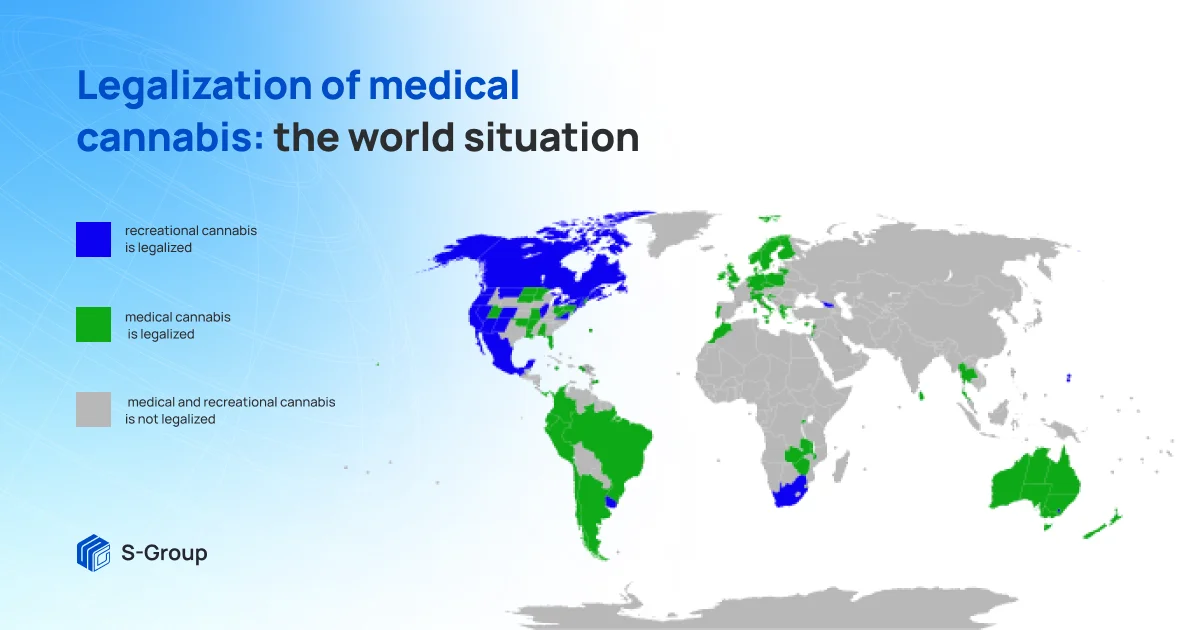Legalization of medical cannabis: the world situation

Disclaimer. This article does not advocate the use, distribution, or production of drugs. It is written for educational purposes, to show in which countries medical cannabis is fully or partially legalized and in which it is illegal. Legalization of medical cannabis does not equal “at will” use of marijuana.
The legalization of cannabis is a much debated issue. However, according to a 2017 Gallup poll, 64 percent of those surveyed said they support marijuana nationally. And medical research shows the benefits of medical cannabis in treating patients. For example, medical cannabis stabilizes mood and blood sugar levels, improves circulation, and helps control seizures.
Medicinal cannabis preparations are used to treat cancer patients during chemotherapy to relieve pain, they improve respiratory function in bronchial asthma, relieve seizures and seizure frequency in epilepsy.
In this article, let's share the experiences of countries where medical marijuana is legalized.
Which countries allow medical cannabis

The most important reforms to legalize medical cannabis tend to take place in the United States. But this transformation is not limited to America alone. Alongside it are European and other countries where cannabis is partially or completely legalized/decriminalized.
USA
In the USA, recreational use of cannabis in various doses is legal in 10 states. Cannabis is decriminalized in 15 states. Medical cannabis is legal in 33 states. Medical cannabis can be obtained from specialized pharmacies.
In 2018, Canada became the first country to legalize and regulate the medical and recreational cannabis market. It is one of the few countries, along with the Netherlands, Australia, and Israel, to allow the export of medical marijuana. Canadian producer Aurora Cannabis, in partnership with Alfred Pedersen & Son in Denmark, produces up to 120,000 kilograms of cannabis a year.
In the USA, medical cannabis is prescribed to treat the following ailments:
- Cancer-related cathexis, nausea or vomiting, weight loss, chronic pain;
- Crohn's disease;
- depression;
- Nausea or weight loss associated with HIV/AIDS;
- anorexia;
- epilepsy;
- Fatal diseases: cancer, HIV/AIDS, cirrhosis of the liver, Alzheimer's.
In Jamaica, Brazil, Colombia, Mexico, Uruguay, Chile, Peru, Paraguay, medical cannabis is completely legal, while recreational cannabis is decriminalized. That is, you can keep a certain amount of weed, set by law. The main difference between medical and recreational cannabis is the THC and cannabidiol content. In ordinary marijuana, THC is 5%-35%, while in medical cannabis it is up to 1%. The percentage of cannabidiol is 6 to 20%.

European countries
The Netherlands is the country with the longest experience in the use of cannabis for medical and recreational purposes. Here, doctors have been prescribing cannabis preparations to patients for over 10 years. The Dutch government has allowed Bedrocan BV to supply cannabis preparations to the country.
In Germany, the use of medical cannabis is permitted in special cases. Patients with severe diseases can buy cannabis preparations in pharmacies to soothe pain.
In Italy, the therapeutic use of cannabis was first permitted in 2007. In contrast to Germany, the costs for patients to buy medical cannabis are covered by the regional health system.
In Spain, people can grow and use the plant themselves for medical purposes. The U.K. government allows the use of marijuana only in cases of severe nausea caused by chemotherapy or multiple sclerosis, if there is a prescription from a doctor.
The Greek and Cypriot governments approved the legalization of medical cannabis in 2018-2019, and allow use only under the strict supervision of a doctor. In Croatia, for example, only one medicinal cannabis drug, Epiduolex, is registered. And in Finland, the oral mucosa spray, Sativex, is approved. It is prescribed to patients with multiple sclerosis.
In Sweden, Latvia, Belgium and Albania, medical cannabis is strictly prohibited — the use, purchase, and sale is illegal. In Ukraine, the use of both medical and recreational cannabis is prohibited.
Countries in Oceania
In Australia, medical marijuana is legal federally and regionally. Quality requirements vary from region to region. In New Zealand, only medical cannabis is legal, recreational cannabis is illegal.
Asian countries
Thailand and Sri Lanka are the Asian countries that have legalized medical cannabis. Japan allows Epiduolex, an oral solution for treating epilepsy. In 2019, a law legalizing medical marijuana went into effect in South Korea.
Countries in Africa
In 2017, Lesotho became the first country on the continent to issue an administrative license for the commercial cultivation of marijuana for medical and scientific purposes. Following Lesotho, medical cannabis production was authorized in Zimbabwe, South Africa, Malawi, Zambia, Uganda, and Rwanda.
In South Africa, medical cannabis preparations can be prescribed for any medical condition if the doctor determines they will help in the treatment.
CIS countries
Both recreational and medical cannabis is banned in all CIS countries except Moldova. Medical cannabis is banned in Moldova, but recreational cannabis is decriminalized.
The legalization of cannabis opens up a wide range of possibilities for its medicinal use. And decriminalization helps reduce crime and increases the country's income through tax revenue.
The S-Group has a medical cannabis business, S-PHARMACEUTICAL. It is a Swiss company that produces and distributes medical cannabis to world-class standards. The cannabis is grown indoors with an automated CMS control system. Read more about S-PHARMACEUTICAL's medical cannabis production here.
Share
Interesting
Would you like to receive a digest of articles?
One email with the best articles of the week.
Sign up so you don't miss anything.